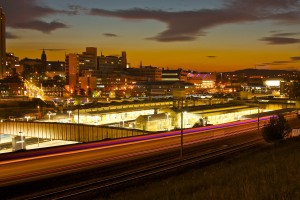I’ve worked in Sheffield for just over a year now – I’m still a newcomer – and perhaps I will be for a very long time!
I came to Sheffield to lead what is one of the UK’s largest universities. Sheffield Hallam teaches more than 31,000 students at any one time. It educates young people in a bewildering range of subjects – from computer science to social work, from history to railway engineering, from nursing to sports science, and so on. It has exceptional reach, drawing students from all over the world and its research has remarkable real-world impact, in materials science, health, social policy. It is a truly remarkable university. At root though, it is this region’s university. It draws its students from all over the world, all over the UK, but predominantly from this city region. It is one of the region’s major suppliers of new, highly qualified young people and one of the region’s largest employers. Sheffield Hallam matters to the city region, but the region matters to Sheffield Hallam too.
It is for that reason, above all, that I was delighted to join a truly visionary piece of work when I arrived. The region’s two universities and the largest health trust in the region – Sheffield University, Sheffield Hallam University and Sheffield Teaching Hospitals Trust – had begun a piece of work to ask tough questions about what the city and region should look like in the middle of the 21st century.
There are fabulous things about this city and region. It has so much to offer. But it also faces serious challenges: productivity lags behind other UK regions; health inequalities are too high; education attainment is too low. For all the great things about living and working in the Sheffield City Region, these are truly debilitating problems. Worse still, other city regions around Europe – themselves old industrial centres like Milan or Bilbao – have made more progress in fixing their economies and are making better progress.
Neither the two universities nor the hospital believes that we have a monopoly of wisdom in solving the challenges we face. But we are genuinely committed to this city and its region – to shaping the lives of people here through the work we do and we have now spent many hours listening to others talk about their aspirations for the city region, their frustrations and their analyses about what needs to be done.
On the basis of that work, we launched an ambitious vision for the long-term future of Sheffield and the city region on Friday, out at the Sheffield Advanced Manufacturing Park. Our vision is of an outward-looking city region, known above all for its skilled and creative people; a region underpinned by innovation-led business and industry and a culture of creativity. A region known for its quality of life, with outstanding health-care provision and environmental stewardship which integrates the best of the urban and the rural; a highly connected city region, physically and virtually, that is open to ideas, people and influences from around the world. An inclusive city region where investment and growth produce prosperity and benefits which are shared by all.
At the core of the vision is a simple challenge: if the city region is to thrive, it needs to grow faster than the national economy, each year and year on year. A growth rate of just one percentage point about the national growth rate would – sustained over 15 years – be transformational. And the key to that is for the region’s stakeholders to commit to two things which are always very difficult in public policy: to a shared vision and to working in collaboration and in a sustained way. The vision document sets out six priority areas for that collaboration to focus on – six areas where a strong local alliance for long-term change can make a real difference.
We want to see a strong ecosystem for innovation and enterprise, joined up health and wellbeing provision closing health inequalities, a transformation in education and skills, a stronger regional green network, sharply enhanced internal and external connectivity and a commitment to maximising the local impact of growth. We hope that our vision document will be widely read – of course. But, much more than that, we hope it will galvanise action.
